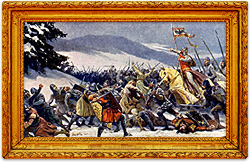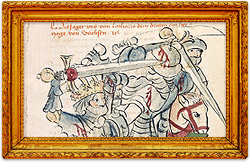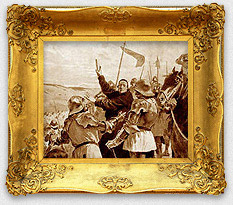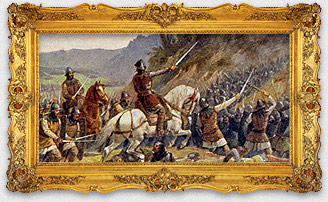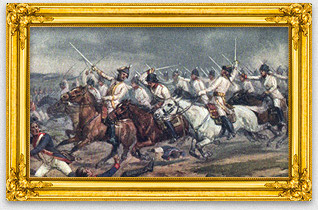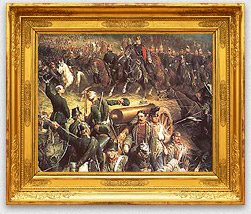Historical Context
In year 1055 prince Břetislav I implemented a new Order of Succession, so called agnatic seniority. According to this order the reign in Bohemia should be passed on the oldest male member of the Přemyslid Dynasty. For younger members there were conferred principalities founded in Moravia (Moravian, of Olomouc and later also of Znojmo).
The Order of Succession of the agnatic seniority did not prove useful for a longer time and was broken several times. In one of these cases when the order was broken, it was the ascension of Soběslav I (1125 – 1140) to the throne of the Prague reigning prince.
Preceding Events
In April 1125 Bohemian Prince Vladislav I dies, who shortly before his death settled the succession of his younger brother Soběslav, which was in contradiction with the then principles of the agnatic seniority. The oldest living member of the dynasty in that time was Soběslav’s cousin Otto II, called The Black, who governed the conferred Principality of Olomouc and who was known to claim open rights to the Prague throne.
In order to strengthen his power and position Soběslav made a campaign to Moravia in the autumn 1125 and revoked Otto’s reign in the conferred Principality of Brno. The banished Prince of Olomouc did not have enough own forces to strike back and therefore he asked German King Lothar III for help. The Roman Monarch being promised an easy victory supported Otto’s claims to the Bohemian Prince’s throne and in the winter at the turn of the years 1125 – 1126 he started a military campaign to Bohemia.
The Course of the Battle of Chlumec
The chronicle entries speak of the winter at the turn of the years 1125 – 1126 as of a particularly cruel one. The Roman king must have been aware of the difficulty of the winter campaign, but he believed Otto’s promises that the expedition would be short and would not meet any stronger resistance. Therefore, Lothar III did not collect an army which would be large enough, but only relied on the warriors from the Eastern half of Saxon Duchy.
The Bohemian Reigning Prince Soběslav found out about the German war plans in advance and therefore had enough time to organize the defence. He succeeded in getting all of the important local great noblemen to his side and in order to boost the battle morale of the Bohemian army, he also got important sacred relics, the purported banner of St. Vojtěch (Saint Adalbert of Prague) which he then had fastened to the spear of St. Wenceslaus.
On 16th February 1126 a great thaw set in. Lothar’s troops started to move and proceeded to the Bohemian territory. They went through the mountain Pass of Nakléř and through the mountains of Krušné hory, where there was an old trade trail, so called Serbian Trail. The melting snow made it more difficult for the German men-at-arms to move. Most of the riders were forced to dismount their horses and take off their armour so that they were able to continue in further advancement.
Lothar’s army spread into a long convoy whose front was made by the regiment led by Otto of Olomouc. Prince Soběslav was awaiting the enemy at the foothills of the fortified settlement of Chlumec.
The crucial battle took place on 18th February 1126. The Saxon troops, tired after a long march, did not have enough time to set a battle formation and did not have time to fight back the prepared Bohemian warriors. Otto of Olomouc died in this cruel fight.
German monarch Lothar III with the rest of his troops escaped on a nearby hill and waited. For him the situation became, from the military point of view, very unfavourable. His army was encircled from all sides by Bohemian fighters so the Roman king did not have any other choice but to go into a losing battle or to try to negotiate.
Result
Prince Soběslav was forethoughtfully aware of the fact that a complete defeat of Lothar III would lead to a protracted war against the whole Empire, this, however, was not in his interest. He, therefore, offered Lothar peace with the proposal of the alliance. At the same time Soběslav had, from the Roman king, the Bohemian lands bestowed as a fiefdom, which was the confirmation of his title of the Bohemian reigning prince.
Historical Importance
Victory of Soběslav I at the Battle of Chlumec led undoubtedly to the inner strengthening and stabilization of the Bohemian state. Soběslav’s main enemy Otto II of Olomouc died at the battle and for next 14 years an efficient monarch became the head of the Bohemian Principality. He also became a loyal ally of Roman king Lothar III.
In honour of his victory in the following years reigning prince Soběslav had the Rotunda of St. George built on Mount Říp.
Author: Mgr. Petr Kovář



